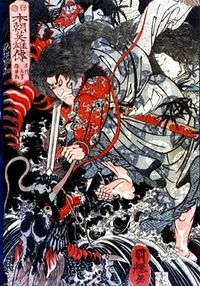Amaterasu

| Shinto | |
|---|---|
This article is part of a series on Shinto |
|
|
|
|
| Kami · Ritual purity · Polytheism · Animism · Japanese festivals · Mythology · Shinto shrines | |
|
|
|
| Amaterasu Omikami · Sarutahiko Okami · Ame-no-Uzume-no-Mikoto · Inari Okami · Izanagi-no-Mikoto · Izanami-no-Mikoto · Susanoo-no-Mikoto · Tsukuyomi-no-Mikoto | |
|
|
|
| Kojiki · Nihon Shoki · Fudoki · Rikkokushi · Shoku Nihongi · Jinnō Shōtōki · Kujiki | |
|
|
|
| Japan · Religion in Japan · Glossary of Shinto · List of Shinto divinities · List of Shinto shrines · Sacred objects · Japanese Buddhism · Mythical creatures | |
|
Shinto Portal |
Amaterasu (天照), Amaterasu-ōmikami (天照大神/天照大御神) or Ōhiru-menomuchi-no-kami (大日孁貴神) is a sun goddess and one of the principal Shinto deities (神 kami). The meaning of her name, Amaterasu-ōmikami, is "the great august kami who shines in the heaven"[1]. She was born from the left eye of Izanagi as he purified himself in a river and went on to become the ruler of the Higher Celestial Plain (Takamagahara).
She is also said to be directly linked in lineage to the Imperial Household of Japan and the Emperor, who are considered descendants of the kami themselves.
Contents |
History
Difference between Kojiki and Nihon Shoki
In Kojiki, Amaterasu was born after Izanagi-no-Mikoto failed to retrieve Izanami-no-Mikoto from Yomi. However, in the Nihon Shoki, Izanagi-no-Mikoto and Izanami-no-Mikoto, who was still alive, together decided to create the supreme deity to reign over the world, and gave birth to Amaterasu.
The episode of sending her grandson to Ashihara no Nakatsukuni (Japan) is also different in two myths. In Kojiki, Amaterasu Omikami commanded her son to rule over the earth, but he refused, saying that earth was too filled with chaos. Amaterasu then sent Ame-no-hohi in his place. After three years of hearing no word from him, Amaterasu's grandson, Ninigi-no-mikoto, took over control of the earth. On the other hand, the main article of Nihon Shoki records the myth that it was Takamimusubi-no-Kami who took control of the event and sent his maternal grandson Ninigi to Japan. The role of Amaterasu Omikami is ambiguous in the episode.
In both cases, Nihon Shoki records similar version of Kojiki episode as "aru-fumi", the alternative episode.
Goddess and the Imperial family
In 1946, Emperor Shōwa issued the Humanity Declaration. It was effectively a renunciation of the conception of akitsumikami (現御神), divinity in human form, and claimed his relation to the people did not rely on such a mythological idea but on a historically developed family-like reliance. Many authors, such as John W. Dower and Herbert Bix, who dispute the former interpretation, consider that by choosing the word akitsumikami (現御神) instead of arahitogami, Emperor Shōwa did not deny his divine descent from the goddess Amaterasu Omikami.
It must however be noted, that according to Shinto myths, all Japanese people descend from the gods, not only the Emperor. On this topic, Emperor Shōwa expressed in December 1945 his point of view to his vice-grand chamberlain Michio Kinoshita: "It is permissible to say that the idea that the Japanese are descendants of the gods is a false conception; but it is absolutely impermissible to call chimerical the idea that the emperor is a descendant of the gods."[2]
Cult of the sun
The worship of Amaterasu to the exclusion of other kami has been described as "the cult of the sun".[3] This phrase can also refer to the early pre-archipelagoan worship of the sun itself.[3]
See also
- Amaterasu in popular culture
- Japanese mythology
- Himiko
- Zalmoxis
References
- ↑ ama means "heaven"; tera is an inflectional form of teru, "to shine"; su is an honorific auxiliary verb which shows respect for the actor; then amaterasu means "to shine in the heaven". And ō means "big" or "great"; mi is a prefix for noble and august beings. See Daijirin, 2nd edition, ISBN 4-385-13900-8.
- ↑ Wetzler, Peter (1998). Hirohito and War. Honolulu: University of Hawai'i Press. p. 3. ISBN 9780824819255.
- ↑ 3.0 3.1 Wheeler, Post (1952). The Sacred Scriptures of the Japanese. New York: Henry Schuman. pp. 393-395. ISBN 1425487874
|
|||||||||||||||||||||||||||||||||||||||||||||||||||||

